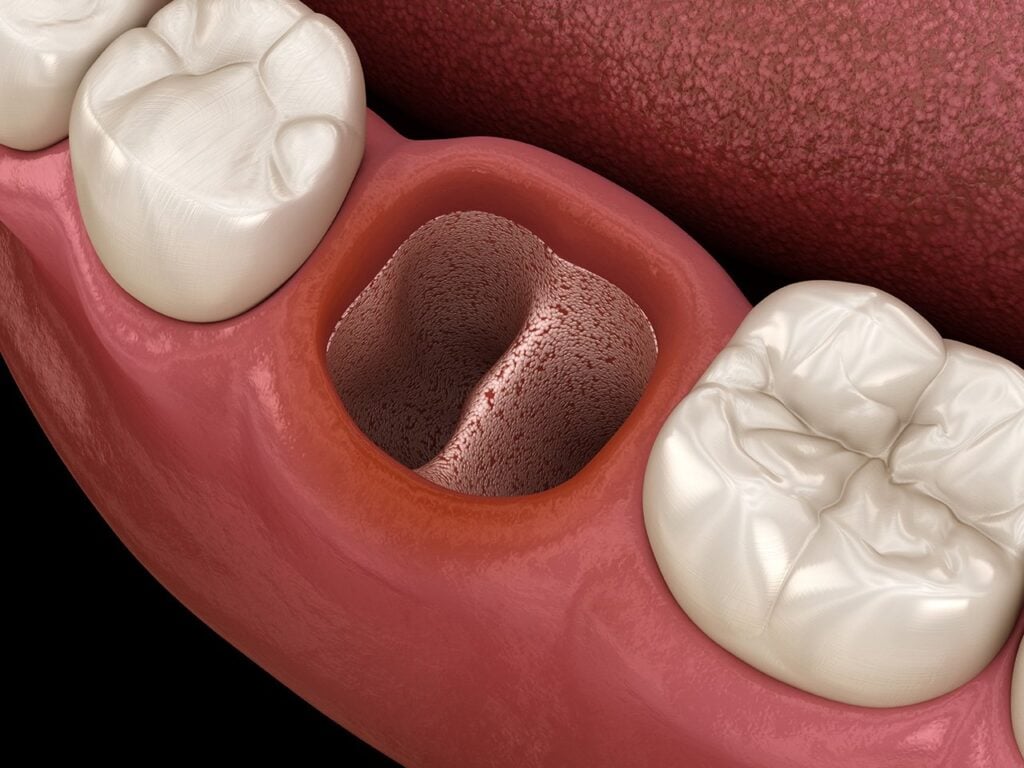Dry socket is a painful ailment that happens after a tooth extraction.
When the blood clot from the extraction site falls out prematurely (within the first 4 days after surgery), dry socket causes extreme pain that may radiate to the jaw, face, and ear. It also causes bad breath.
The highest risk for this condition is between days 2-3 after tooth extraction. After day 4, the risk of dry socket is passed. This condition rarely happens (about 4% of all extractions) and is most common after bottom wisdom teeth extraction.
Severe cases of this condition usually occur within the first day after surgery and will need to be treated by your dentist. But moderate cases can be treated at home and may resolve on their own in several days.
What is dry socket?
Dry socket is a very painful condition when a blood clot in an extraction site falls out too early. This exposes the underlying bone and causes intense pain. It is usually caused by creating a sucking motion – such as drinking through a straw, smoking, or vigorous mouth-rinsing.
Within the first 24 hours after a tooth extraction, a blood clot forms in the empty hole left in the jaw bone.
The blood clot is important because:
- it stops the extraction site from bleeding
- it stimulates bone healing.
If the blood clot comes out before the bone has healed enough, this can be detrimental to healing and cause complications like dry socket.
Without the blood clot’s protection, the bone is exposed, leading to intense radiating pain along the face.
Cold exposure, such a drinking cold water, can also cause pain.
When can you get dry socket?
You might experience this condition within the first three days after tooth extraction.
But after the 4th day, your risk for dry socket is much lower as the blood clot will have enough time to form.
What does dry socket look like?

A dry socket looks like an empty hole with a light color at the bottom of the extraction site. The light color is from the white-ish bone showing. A normal extraction site is a socket with a dark red blood clot formation covering the bone.
The color of the material over the bone in a dry socket will vary, ranging from yellow to grayish-green to a darker red. The color will differ based on the type of dry socket you might have.
Symptoms of dry socket:
- More bleeding than usual (if you get dry socket within the first 24 hours)
- Intense throbbing pain in the tooth socket that radiates to the bone or the face
- Pain upon cold temperature
- Bad breath
- foul taste in the mouth
- Headaches
- Dizziness
- Insomnia
- Infection (rare)
- Fever (rare)
In some rare cases, this condition can lead to an infection that causes “lockjaw” (trismus).
Is dry socket painful?
Yes, dry socket can be extremely painful. It feels like a severe aching that begins in the extraction site and radiates out. The sooner the blood clot comes out, the more severe the pain and the more you’ll need to see your dentist.
It’s not normal to feel extensive pain or bleeding 4 hours or more after tooth extraction and will require a dental visit right away.
How do I know I have dry socket?
Timing is everything. If you experience persistent pain after 3-5 days post-extraction, it’s a sign of a possible dry socket.
Dry socket treatment
This condition usually requires dental treatment. Your dentist will take a look and decide on the type of treatment based on the condition of the exposed bone and your level of pain.
There are several treatment options for dry socket:
- Cleaning/ irrigating the tooth socket
- Application of dry socket paste
- Bone grafting material
- Surgical foam
- Prescription pain meds
1. Cleaning out the tooth socket
To clean out the tooth socket, your dentist will carefully remove debris from the extraction site and irrigate it.
2. Dry socket past application
Your dentist will apply a medicated dry socket paste dressing to provide pain relief and protection from new debris getting into the extraction site.
The medicated dressing may need to be changed every 1-2 days for the next several days.
3. Bone grafting material
Another treatment is packing the tooth socket with bone graft material to help the bone grow back and promote healing. This can help in the long-run for a patient with thinner bone.
4. Surgical foam
In some cases, your dentist can place surgical foam in the extraction site to promote healing and prevent excess bleeding.
5. Prescription medications
Most over-the-counter pain meds are effective enough to relieve pain from this disease.
Your dentist may prescribe prescription pain meds if needed, as well as antibiotics.

Dry socket care at home
You can relieve pain at home with over-the-counter pain meds.
You can try these effective home remedies for pain relief:
- Warm salt water rinse
- Warm and cold compress
- Teabags
1.Warm salt water rinse
Gently rinse with warm salt water to clean the extraction site, reduce bacteria, and promote healing.
Note: vigorous mouth rinsing can actually cause dry socket or worsen it. So be very careful not to swish too hard. Just let the liquid sit in the extraction site and let it dribble out rather than spitting.
2. Warm and/or cold compress
Press a cold towel or compress on the side of your face by the dry socket to reduce pain and swelling around the jaw bone.
You can also try using a warm compression as the swelling starts to go down. But wait at least 24 hours after the tooth extraction.
3. Teabags
Teabags can help relieve pain and inflammation from a dry socket. Take a wet tea bag and place it gently against the extraction site.
Another great option is placing the teabag in the refrigerator to use it as a soothing cold compress.
Dry socket healing time
You can expect it to take about 7-10 days to heal from dry socket as new tissue begins to cover the exposed bone and heal the wound.
If you have periodontal disease or thin bone, it may take longer to heal.
How long does dry socket pain last?
Pain from a dry socket can last anywhere from 1-2 weeks unless your dentist treats it.
How to prevent dry socket
Carefully following your dentist’s instructions after the tooth extraction will help prevent complications like dry socket.
- Do not smoke (any type of smoking)
- Do not drink through a straw
- Do not use tobacco products
- Avoid vigorous mouth rinsing
- Avoid vigorous mouth movements
- Do not spit and try not to cough or sneeze if possible
- Leave the extraction site alone
- Avoid carbonated drinks
- Eat soft foods for the first 4 days after oral surgery
- Avoid sharp, spicy, and hot in temperature foods
- Avoid physical strain or exercise
- Do not soak gauze in water before placing them on the extraction site
- Take your antibiotics if prescribed
Ask your dentist if interested in taking extra precautions such as antibiotic mouthwash and dressing.
Risk factors of dry socket
The following put you at a higher risk for this condition:
- Ages 40-45
- Female gender
- Birth control pills
- History of dry socket
- Compromised immunity
- Periodontal (gum) disease
- Smoking or other tobacco use
- Impacted wisdom teeth extraction
- Poor oral hygiene or dental health
Conclusion:
In conclusion, dry socket is an excruciating condition where the healing blood clot falls out too early (before day 4 after an extraction), exposing the underlying bone.
This can be caused by vigorous mouth movements, smoking, drinking through a straw, etc. Other factors and health conditions can put you at a higher risk for dry socket.
To avoid this painful condition, it’s imperative to follow your dentist’s aftercare instructions to prevent complications and allow faster healing.
This condition can sometimes resolve on its own, or you may need to see your dentist for treatment. There are various treatment options for dry socket depending not the severity of your case.
If you are experiencing pain after a tooth extraction, come in for a same-day emergency dental visit so we can help you get out of pain and heal faster!
by Dr. Christine Coughlin DDS
Learn more:
Tooth Extraction – Cost, What to expect, Procedure, Aftercare & Recovery



